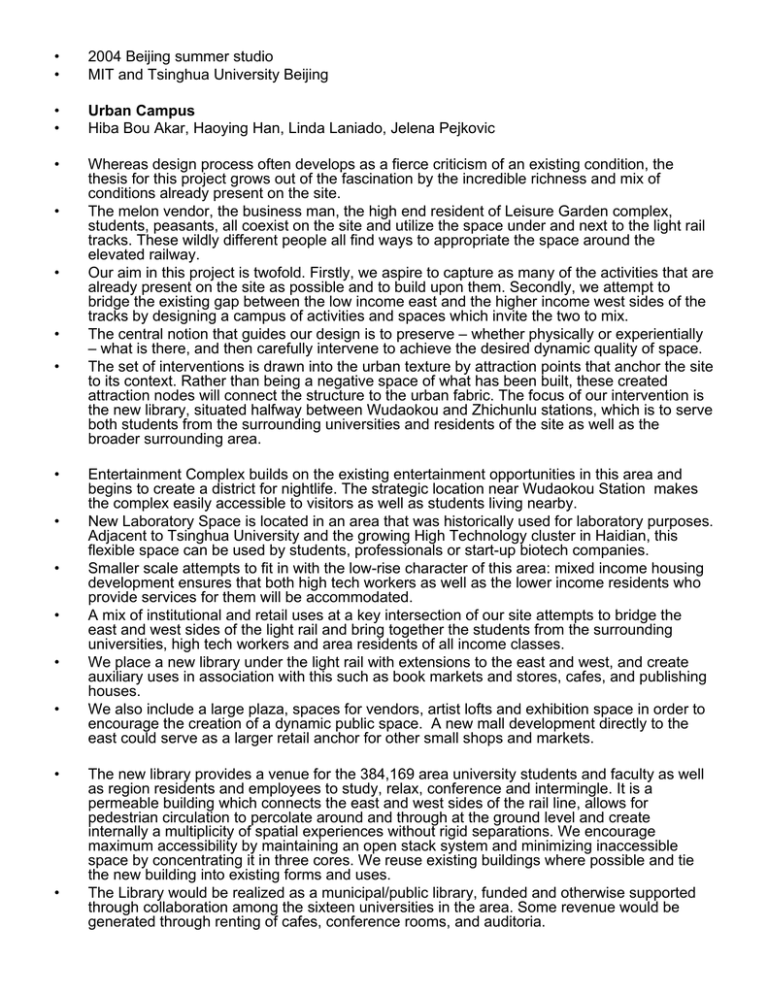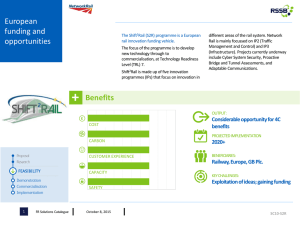• 2004 Beijing summer studio MIT and Tsinghua University Beijing
advertisement

• • 2004 Beijing summer studio MIT and Tsinghua University Beijing • • Urban Campus Hiba Bou Akar, Haoying Han, Linda Laniado, Jelena Pejkovic • Whereas design process often develops as a fierce criticism of an existing condition, the thesis for this project grows out of the fascination by the incredible richness and mix of conditions already present on the site. The melon vendor, the business man, the high end resident of Leisure Garden complex, students, peasants, all coexist on the site and utilize the space under and next to the light rail tracks. These wildly different people all find ways to appropriate the space around the elevated railway. Our aim in this project is twofold. Firstly, we aspire to capture as many of the activities that are already present on the site as possible and to build upon them. Secondly, we attempt to bridge the existing gap between the low income east and the higher income west sides of the tracks by designing a campus of activities and spaces which invite the two to mix. The central notion that guides our design is to preserve – whether physically or experientially – what is there, and then carefully intervene to achieve the desired dynamic quality of space. The set of interventions is drawn into the urban texture by attraction points that anchor the site to its context. Rather than being a negative space of what has been built, these created attraction nodes will connect the structure to the urban fabric. The focus of our intervention is the new library, situated halfway between Wudaokou and Zhichunlu stations, which is to serve both students from the surrounding universities and residents of the site as well as the broader surrounding area. • • • • • • • • • • • • Entertainment Complex builds on the existing entertainment opportunities in this area and begins to create a district for nightlife. The strategic location near Wudaokou Station makes the complex easily accessible to visitors as well as students living nearby. New Laboratory Space is located in an area that was historically used for laboratory purposes. Adjacent to Tsinghua University and the growing High Technology cluster in Haidian, this flexible space can be used by students, professionals or start-up biotech companies. Smaller scale attempts to fit in with the low-rise character of this area: mixed income housing development ensures that both high tech workers as well as the lower income residents who provide services for them will be accommodated. A mix of institutional and retail uses at a key intersection of our site attempts to bridge the east and west sides of the light rail and bring together the students from the surrounding universities, high tech workers and area residents of all income classes. We place a new library under the light rail with extensions to the east and west, and create auxiliary uses in association with this such as book markets and stores, cafes, and publishing houses. We also include a large plaza, spaces for vendors, artist lofts and exhibition space in order to encourage the creation of a dynamic public space. A new mall development directly to the east could serve as a larger retail anchor for other small shops and markets. The new library provides a venue for the 384,169 area university students and faculty as well as region residents and employees to study, relax, conference and intermingle. It is a permeable building which connects the east and west sides of the rail line, allows for pedestrian circulation to percolate around and through at the ground level and create internally a multiplicity of spatial experiences without rigid separations. We encourage maximum accessibility by maintaining an open stack system and minimizing inaccessible space by concentrating it in three cores. We reuse existing buildings where possible and tie the new building into existing forms and uses. The Library would be realized as a municipal/public library, funded and otherwise supported through collaboration among the sixteen universities in the area. Some revenue would be generated through renting of cafes, conference rooms, and auditoria.



